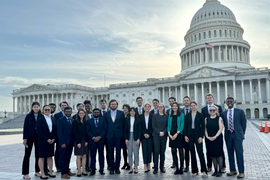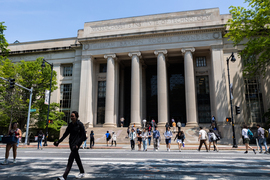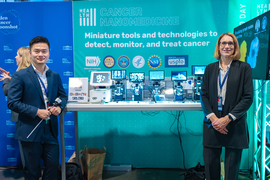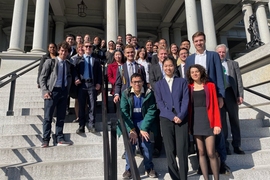Anoushka Bose ’20 spent the summer of 2018 as an MIT Washington program intern, applying her nuclear physics education to arms control research with a D.C. nuclear policy think tank.
“It’s crazy how much three months can transform people,” says Bose, now an attorney at the Department of Justice.
“Suddenly, I was learning far more than I had expected about treaties, nuclear arms control, and foreign relations,” adds Bose. “But once I was hooked, I couldn’t be stopped as that summer sparked a much broader interest in diplomacy and set me on a different path.”
Bose is one of hundreds of MIT undergraduates whose academic and career trajectories were influenced by their time in the nation’s capital as part of the internship program.
Leah Nichols ’00 is a former D.C. intern, and now executive director of George Mason University’s Institute for a Sustainable Earth. In 1998, Nichols worked in the office of U.S. Senator Max Baucus, D-Mont., developing options for protecting open space on private land.
“I really started to see how science and policy needed to interact in order to solve environmental challenges,” she says. “I’ve actually been working at that interface between science and policy ever since.”
Marking its 30th anniversary this year, the MIT Washington Summer Internship Program has shaped the lives of alumni, and expanded MIT’s capital in the capital city.
Bose believes the MIT Washington summer internship is more vital than ever.
“This program helps steer more technical expertise, analytical thinking, and classic MIT innovation into policy spaces to make them better-informed and better equipped to solve challenges,” she says. With so much at stake, she suggests, it is increasingly important “to invest in bringing the MIT mindset of extreme competence as well as resilience to D.C.”
MIT missionaries
Over the past three decades, students across MIT — whether studying aeronautics or nuclear engineering, management or mathematics, chemistry or computer science — have competed for and won an MIT Washington summer internship. Many describe it as a springboard into high-impact positions in politics, public policy, and the private sector.
The program was launched in 1994 by Charles Stewart III, the Kenan Sahin (1963) Distinguished Professor of Political Science, who still serves as the director.
“The idea 30 years ago was to make this a bit of a missionary program, where we demonstrate to Washington the utility of having MIT students around for things they’re doing,” says Stewart. “MIT’s reputation benefits because our students are unpretentious, down-to-earth, interested in how the world actually works, and dedicated to fixing things that are broken.”
The outlines of the program have remained much the same: A cohort of 15 to 20 students is selected from a pool of fall applicants. With the help of MIT’s Washington office, the students are matched with potential supervisors in search of technical and scientific talent. They travel in the spring to meet potential supervisors and receive a stipend and housing for the summer. In the fall, students take a course that Stewart describes as an “Oxbridge-type tutorial, where they contextualize their experiences and reflect on the political context of the place where they worked.”
Stewart remains as enthusiastic about the internship program as when he started and has notions for building on its foundations. His wish list includes running the program at other times of the year, and for longer durations. “Six months would really change and deepen the experience,” he says. He envisions a real-time tutorial while the students are in Washington. And he would like to draw more students from the data science world. “Part of the goal of this program is to hook non-obvious people into knowledge of the public policy realm,” he says.
Prized in Washington
MIT Vice Provost Philip Khoury, who helped get the program off the ground, praised Stewart’s vision for developing the initial idea.
“Charles understood why science- and technology-oriented students would be great beneficiaries of an experience in Washington and had something to contribute that other internship program students would not be able to do because of their prowess, their prodigious abilities in the technology-engineering-science world,” says Khoury.
Khoury adds that the program has benefited both the host organizations and the students.
“Members of Congress and senior staff who were developing policies prized MIT students, because they were powerful thinkers and workaholics, and students in the program learned that they really mattered to adults in Washington, wherever they went.”
David Goldston, director of the MIT Washington Office, says government is “kind of desperate for people who understand science and technology.” One example: The National Institute of Standards and Technology has launched an artificial intelligence safety division that is “almost begging for students to help conduct research and carry out the ever-expanding mission of worrying about AI issues,” he says.
Holly Krambeck ’06 MST/MCP, program manager of the World Bank Data Lab, can attest to this impact. She hired her first MIT summer intern, Chae Won Lee, in 2013, to analyze road crash data from the Philippines. “Her findings were so striking, we invited her to join the team on a mission to present her work to the government,” says Krambeck.
Subsequent interns have helped the World Bank demonstrate effective, low-cost, transit-fare collection systems; identify houses eligible for hurricane protection retrofits under World Bank loans; and analyze heatwave patterns in the Philippines to inform a lending program for mitigation measures.
“Every year, I’ve been so impressed by the maturity, energy, willingness to learn new skills, and curiosity of the MIT students,” says Krambeck. “At the end of each summer, we ask students to present their projects to World Bank staff, who are invariably amazed to learn that these are undergraduates and not PhD candidates!”
Career springboard
“It absolutely changed my career pathway,” says Samuel Rodarte Jr. ’13, a 2011 program alumnus who interned at the MIT Washington Office, where he tracked congressional hearings related to research at the Institute. Today, he serves as a legislative assistant to Senate Majority Leader Charles E. Schumer. An aerospace engineering and Latin American studies double major, Rodarte says the opportunity to experience policymaking from the inside came “at just the right time, when I was trying to figure out what I really wanted to do post-MIT.”
Miranda Priebe ’03 is director of the Center for Analysis of U.S. Grand Strategy for the Rand Corp. She briefs groups within the Pentagon, the U.S. Department of State, and the National Security Council, among others. “My job is to ask the big question: Does the United States have the right approach in the world in terms of advancing our interests with our capabilities and resources?”
Priebe was a physics major with an evolving interest in political science when she arrived in Washington in 2001 to work in the office of Senator Carl Levin, D-Mich., the chair of the Senate Armed Services Committee. “I was working really hard at MIT, but just hadn’t found my passion until I did this internship,” she says. “Once I came to D.C. I saw all the places I could fit in using my analytical skills — there were a million things I wanted to do — and the internship convinced me that this was the right kind of work for me.”
During her internship in 2022, Anushree Chaudhuri ’24, urban studies and planning and economics major, worked in the U.S. Department of Energy’s Building Technologies Office, where she hoped to experience day-to-day life in a federal agency — with an eye toward a career in high-level policymaking. She developed a web app to help local governments determine which census tracts qualified for environmental justice funds.
“I was pleasantly surprised to see that even as a lower-level civil servant you can make change if you know how to work within the system.” Chaudhuri is now a Marshall Scholar, pursuing a PhD at the University of Oxford on the socioeconomic impacts of energy infrastructure. “I’m pretty sure I want to work in the policy space long term,” she says.










